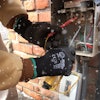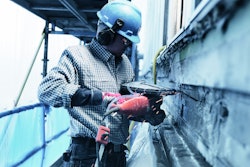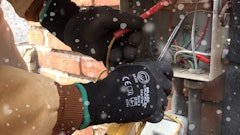AmQuip has become the first crane rental company in North America to fit the TRAM fall prevention system to its cranes.
TRAM – Travel Restraint Access Module – is a movable total restraint system that allows employees to move on top of cranes with no risk of falling.
It was originally developed for worker safety on bulk liquid tankers but has now been refined for cranes after several pilot installations in Europe and Australia have proved the concept.
TRAM is produced by Chicago-based Standfast Corporation.
AmQuip's TRAM retrofit program is initially targeting its largest telescopic boom cranes, where workers need access to the top of the crane to assemble attachments.
"We have identified 20 of our largest all-terrains as a priority for TRAM," said AmQuip VP for Risk Management Jeff Hammons. "We take safety seriously and most of our business is with customers who are equally safety sensitive. Neither AmQuip nor its customers can accept employees being unprotected on top of cranes any longer. TRAM provides a safe and convenient solution while still meeting compliance with OSHA’s new Crane and Derrick standard, 1926.1400."
The first AmQuip units to be fitted with TRAM are four of its Grove GMK 7550 cranes, including two that have Grove's Mega Wing attachments. The first installation was completed mid-August. The next three installations will be completed by the end of September.
The GMK 7550 is a 550-U.S.-ton (450 metric tonne) capacity telescopic crane with a five-section, 197-ft. (60m) main boom and jib extensions up to 240 ft. (73m).
The TRAM system comprises provides a secure handlebar at waist level that moves along a rail installed at foot-level along the length of the main boom. A lanyard or pair of lanyards attach to the handlebar and to the rigger’s harness. By tying off at waist level rather than foot level, the TRAM user has no distance to fall in the event of a slip or trip, yet still has total freedom to do the work required.
Meanwhile the movable handlebar provides support while walking along the boom of the crane. The handle rotates 180 degrees, if required, to aid manoeuvrability and folds down for storage when not in use.
Ascent and descent is often the riskiest part of working at height. TRAM makes this not just safer but easier too. As the user climbs up the side of the crane, he or she clips the lanyard onto the handle. Squeezing the hand brake releases an air-powered spring that pushes the arm gently but firmly to vertical, helping the user climb up and over onto the top of the boom. Similar assistance is given in descent. A deadman’s brake prevents the arm from moving along the rail unless the hand brake is squeezed.
Jeff Hammons added: "We spent a long time researching ways to assemble large cranes in a safer way. When we discovered TRAM, it was a clear choice not just because it is so effective, but because it is also convenient and very easy to use.
"I have found, in my 20-plus years providing safety and risk management services, that if something is not convenient and comfortable, people won't use it. TRAM meets all our criteria. It allows the employees to go about their work at their normal pace with no impediment - it prevents them from falling, and it stows away when it is not in use."
TRAM has been tested and certified by accredited laboratories as meeting all relevant international standards.
Standfast has now retrofitted TRAM in Europe and Australia to several sizes and makes of both telescopic and lattice boom mobile cranes from 60 tonne up to 600 tonne capacity upwards, as well as on gantry beams of overhead travelling cranes.
Early crane installations required a degree of modification to fit each application, depending on the design of the crane. However, with growing demand from crane owners worldwide, Standfast has now developed, refined and standardised its methodology for either welding, banding or bonding TRAM rails to most crane types.
Crane owners that have already installed TRAM systems include: Australian hire companies Boom Logistics and Hanchard Cranes; wind power company Suzlon Energy Australia; New Zealand Crane Group; Ainscough Crane Hire of the UK; and Royal Saan of the Netherlands.
As well as providing crane owners with a retrofit safety solution, Standfast supplies TRAM systems to Terex Cranes for fitment on original equipment. Terex offers TRAM as a recommended option on its larger all terrain cranes and has been recently specified by several Terex customers including King Lifting in the UK.
Standfast is also in discussions with other OEM manufacturers that are under pressure from customers to develop improved height safety measures that are both practical and affordable.
Standfast CEO Cameron Baker said: "The TRAM fall restraint system has attracted a lot of interest from crane owners and manufacturer alike. Safety authorities all over the world are really tightening up on working at height since falls are the biggest cause of industrial accidents. They are pressuring major contractors to raise their game in eliminating fall risk.
"Producing a system that offers riggers safety while still giving them the freedom to do their work seems to have been quite a challenge for the crane industry. Fall arrest systems that leave guys dangling in the air and risking shock trauma are clearly inadequate. Fall restrain systems like TRAM that prevent falls in the first place are a far better approach.
"We are glad to see that TRAM is becoming recognised as the solution of choice in the crane industry. With AmQuip showing industry leadership, we have no doubt that more North American crane owners will soon be turning on to TRAM."
AmQuip Crane Rental LLC is a leading US crane rental company, serving the Northeast, Mid-Atlantic region, and most Midwest and Southern states. Significant shareholders include Altpoint Capital Partners, Bard Capital, Wesley Group, and Lehman Brothers Holdings.



















